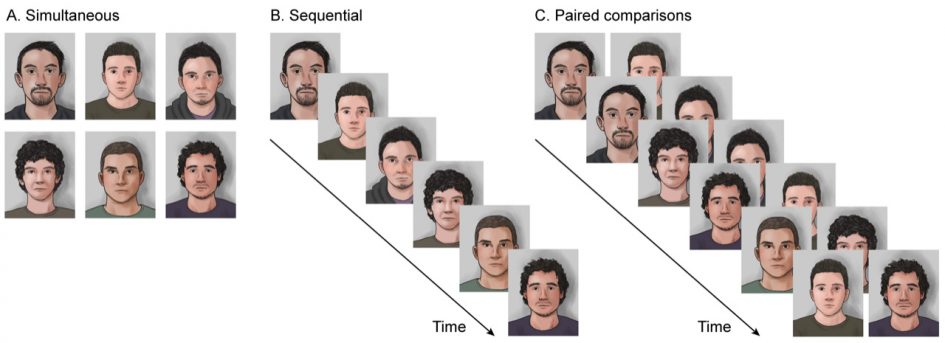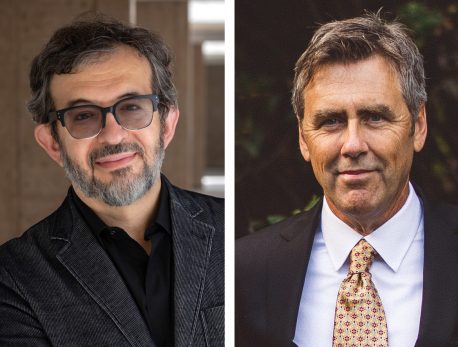
July 14, 2020
Salk scientists devise a new lineup method to help eyewitnesses more accurately identify suspects
Salk scientists devise a new lineup method to help eyewitnesses more accurately identify suspects
LA JOLLA—People wrongfully accused of a crime often wait years—if ever—to be exonerated. Many of these wrongfully accused cases stem from unreliable eyewitness testimony. Now, Salk scientists have identified a new way of presenting a lineup to an eyewitness that could improve the likelihood that the correct suspect is identified and reduce the number of innocent people sentenced to jail. Their report is published in Nature Communications on July 14, 2020.
“Misidentification by eyewitnesses is a long-standing problem in our society. Our new lineup method uncovers the structure of eyewitness memory, removes decision bias from the identification process, and quantifies performance of individual witnesses,” says Salk Professor Thomas D. Albright, co-corresponding author of the study. “This study is a great example of using laboratory science to bring about criminal justice reform.”
In the United States, nearly 70 percent of DNA exonerations are due to misidentifications by eyewitnesses, according to the Innocence Project. To overcome this societal problem, research has focused on factors that influence the likelihood that a witness will identify the correct person. One key factor is the way individuals are presented to the eyewitness during the lineup, according to Albright, who co-chaired a National Academy of Sciences committee to examine the validity of eyewitness identification. Albright, an expert in the fields of visual perception and recognition, taps into decades of research suggesting that people commonly misperceive visual events, and memories of those events are continuously augmented and deteriorate over time.
Currently, the two most common (or traditional) methods used by law enforcement are known as simultaneous and sequential lineups. In the simultaneous method the eyewitness views six photographs of individuals at the same time; in the sequential method the eyewitness views six photos, one at a time. The witness then either identifies a suspect or rejects the lineup if no face matches their memory of the crime scene.

Click here for a high-resolution image.
Credit: Gepshtein et al., Nature Communications
The research team sought to create a new lineup method that would help estimate the strengths of memories for each face and eliminate unconscious biases that shape decisions without awareness.
“Traditional lineups just reveal the top choice—the tip of the iceberg. But the cause of the witness’s decision is ambiguous. It may reflect strong memory for the culprit, or it may mean that the witness was not very discerning,” says Albright. “Our new procedure overcomes that ambiguity by revealing the strength of recognition memory for all lineup faces.”

Click here for a high-resolution image.
Credit: Salk Institute
The scientists used a technique, called the method of paired comparisons, which works similar to how an optometrist gives an eye exam: Just like looking through pairs of lenses and stating which lens is clearer, the eyewitness is shown two photographs of individuals at a time and they choose the one that looks more similar to the person they remember from the crime scene. The procedure yields an estimate of the strength of recognition memory for each lineup face. Statistical analysis of these memory strengths then reveals the probability of correctly identifying the culprit.
“Our methods derive from a branch of science called sensory psychophysics,” says Staff Scientist Sergei Gepshtein, first and co-corresponding author of the paper, who founded and directs the Collaboratory for Adaptive Sensory Technologies at Salk. “Psychophysical tools are designed to reveal how properties of the physical world are ordered—or ‘scaled’—in the mind. Our approach allowed us to peek into the ‘black box’ and measure how lineup faces are organized in the witness’s memory in terms of their similarity to the culprit.”
The paired comparison method yields greater information about the identity of the culprit than previous methods. What is more, it offers an unprecedented quantitative index of certainty for individual eyewitnesses, which is what the judge and jury really need to know.
“The conduct of a lineup is just one application of our method,” says Gepshtein. “Another application is selection of lineup ‘fillers,’ which are faces of people known to be innocent. The fillers should not be too similar or too dissimilar to the suspect. Because the new method reveals the perceived similarity of faces, it can be used to optimize the choice of lineup fillers.”
The paired comparison lineup holds much promise as a research tool as well as a practical tool for investigation and prosecution of crimes. The authors hope that the new technique will soon be applied in real police casework, leading to more correct identifications and fewer wrongful convictions.
“Convictions should be based on science, not precedent,” says Albright.
Other authors included Yurong Wang, Fangchao He and Dinh Diep of Salk. The work was supported by awards from Arnold Ventures and from the Innovation Grants Program of the Salk Institute for Biological Studies.
DOI: 10.1038/s41467-020-17194-5
JOURNAL
Nature Communications
AUTHORS
Sergei Gepshtein, Yurong Wang, Fangchao He, Dinh Diep and Thomas D. Albright.
Office of Communications
Tel: (858) 453-4100
press@salk.edu
Unlocking the secrets of life itself is the driving force behind the Salk Institute. Our team of world-class, award-winning scientists pushes the boundaries of knowledge in areas such as neuroscience, cancer research, aging, immunobiology, plant biology, computational biology and more. Founded by Jonas Salk, developer of the first safe and effective polio vaccine, the Institute is an independent, nonprofit research organization and architectural landmark: small by choice, intimate by nature, and fearless in the face of any challenge.